Abstract
Antibiotics were used as probes of ribosome topology and function. Studies of [14C]chloramphenicol and [14C]erythromycin binding to ribosomes and polyribosomes revealed the following features. The requirement of high K+ concentration (150 mM) for [14C]chloramphenicol binding to NH4Cl-washed ribosomes resulted from the washing procedure. Neither native 70S ribosomes nor polyribosomes require K+ greater than 30 mM for [14C]chloramphenicol binding. Whereas [14C]chloramphenicol binds to both ribosomes and polyribosomes, [14C]erythromycin binds essentially only to ribosomes. After removal of peptidyl-transfer ribonucleic acid (tRNA) from polyribosomes, [14C]erythromycin could then be bound. The effects of a number of antibiotics on [14C]chloramphenicol binding to ribosomes and polyribosomes was assessed. It was found that most of the macrolides (erythromycin, carbomycin, spiramycin III, niddamycin, oleandomycin, and tylosin) and streptogramins A and B (vernamycin A, PA114A, vernamycin Bα, and PA114B) inhibited chloramphenicol binding to NH4Cl-washed and native 70S ribosomes, but not to polyribosomes. After removal of peptidyl-tRNA from polyribosomes, [14C]chloramphenicol binding was then inhibited. In contrast, sparsomycin and althiomycin inhibited chloram-phenicol binding to polyribosomes, but not to ribosomes. After removal of peptidyl-tRNA from polyribosomes, sparsomycin and althiomycin were then ineffective. The presence of peptidyl-tRNA on polyribosomes apparently is required for binding of sparsomycin and althiomycin, but prevents binding of most macrolides and streptogramins. The lincosaminides (lincomycin and celesticetin) and methymycin (a small macrolide) inhibited [14C]chloramphenicol binding to NH4Cl-washed and native 70S ribosomes best, but also inhibited the binding to polyribosomes. The amino nucleosides and other antibiotics tested do not seem to interact strongly with the major chloramphenicol-binding site. These results provide knowledge of the interrelationships between antibiotic and substrate ribosome binding sites which should eventually contribute to a map of ribosomal topology.
Full text
PDF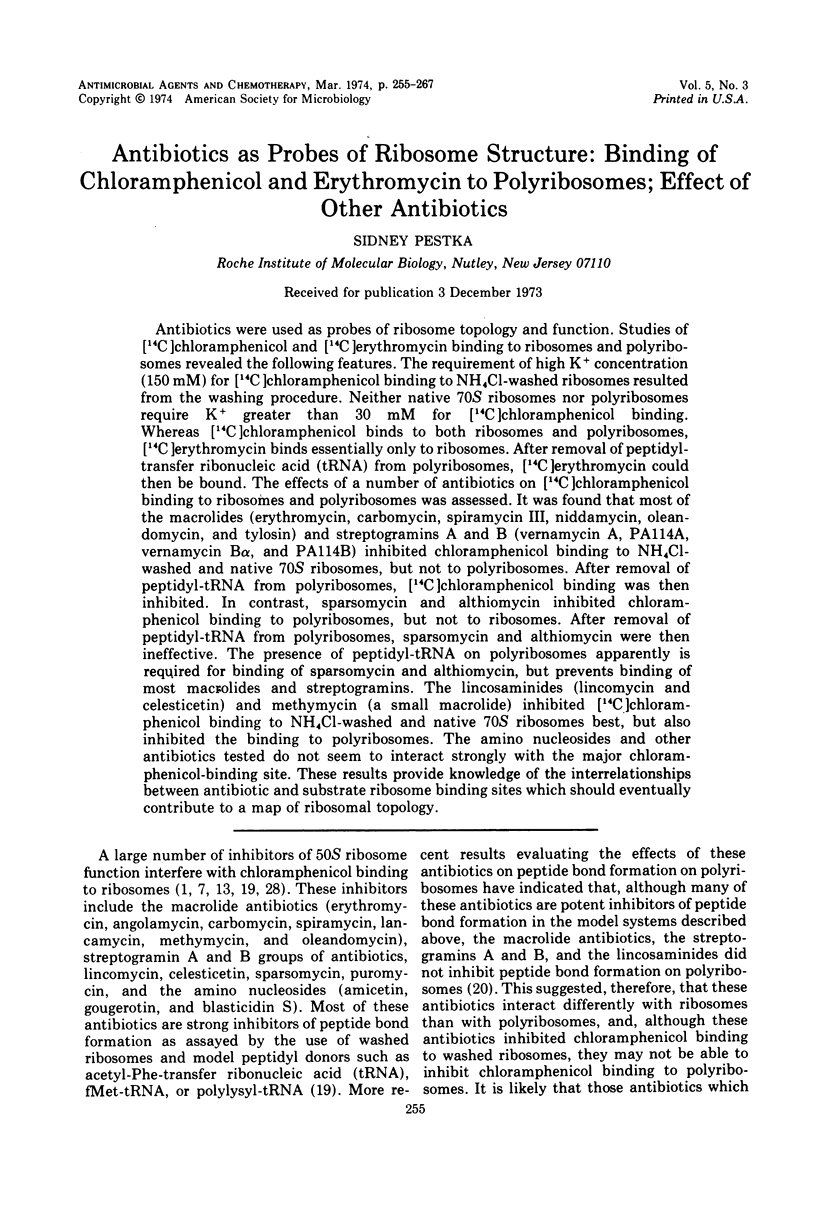
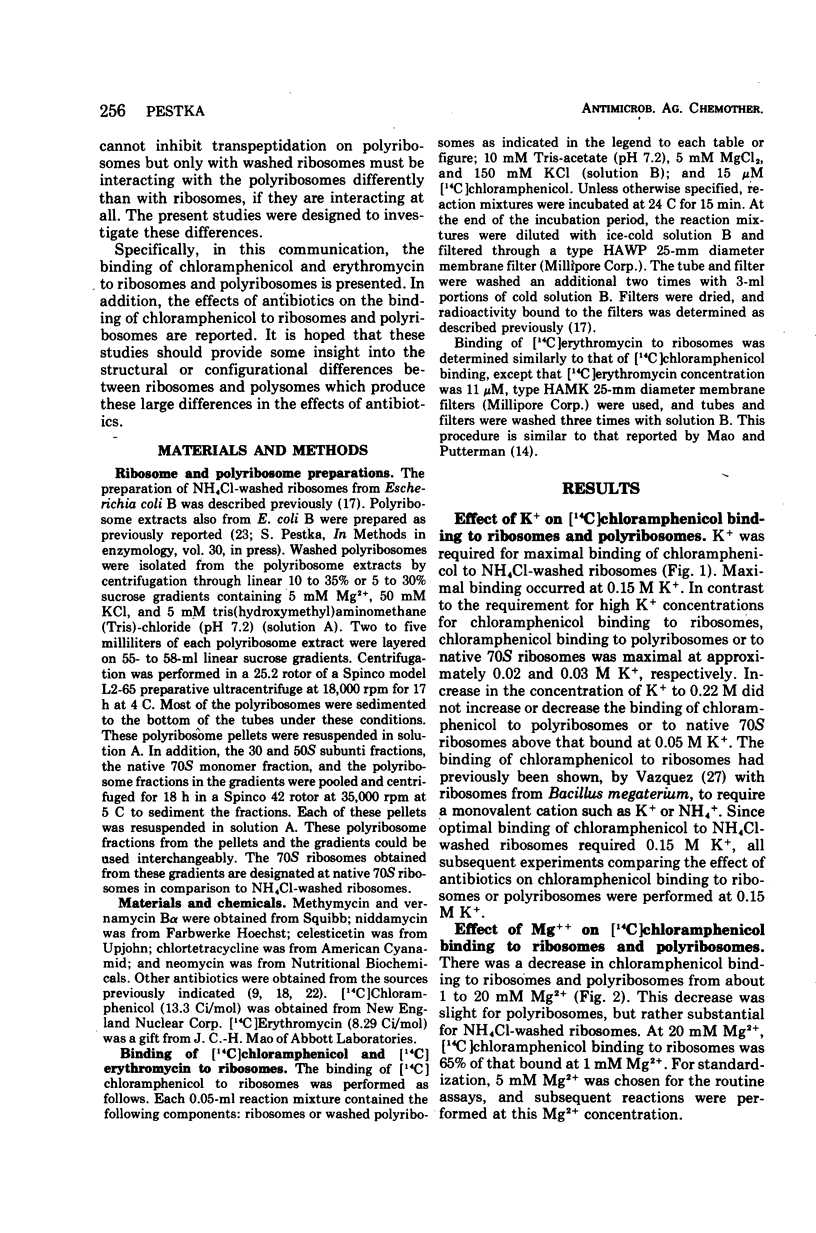
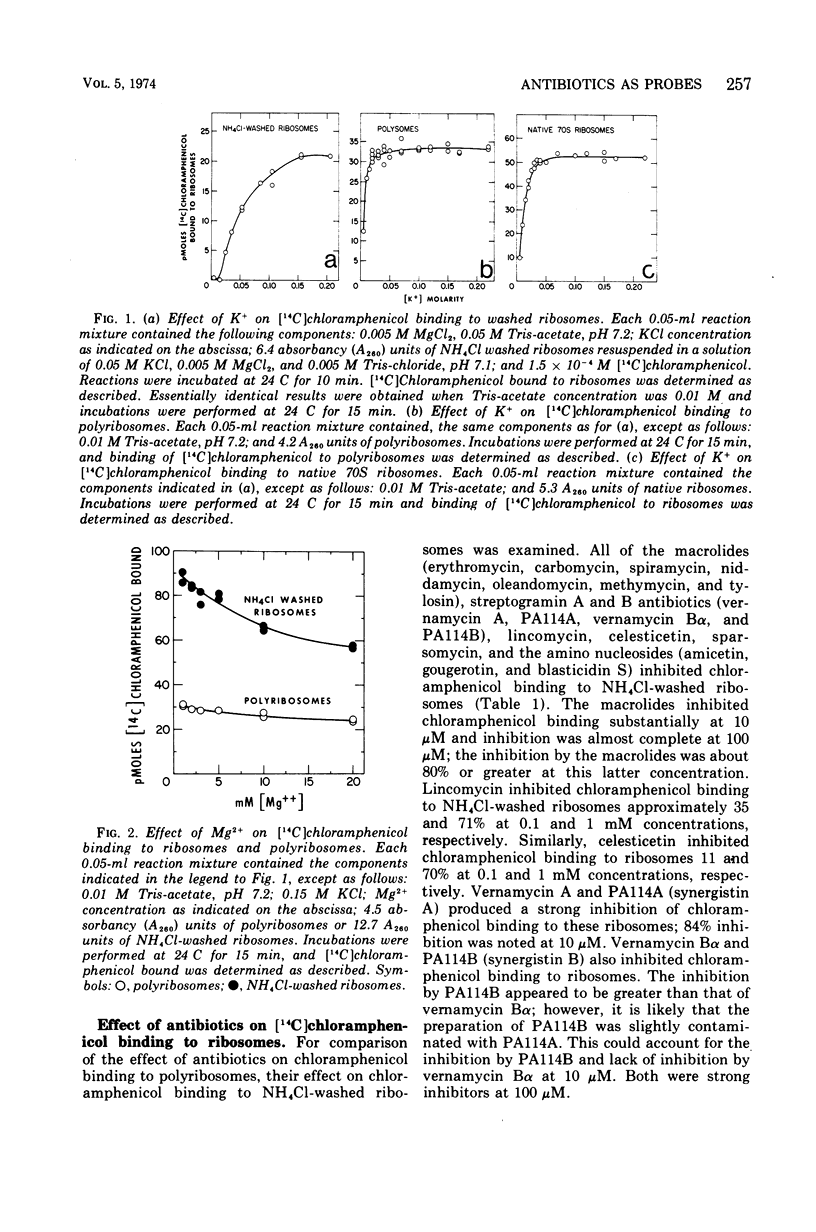


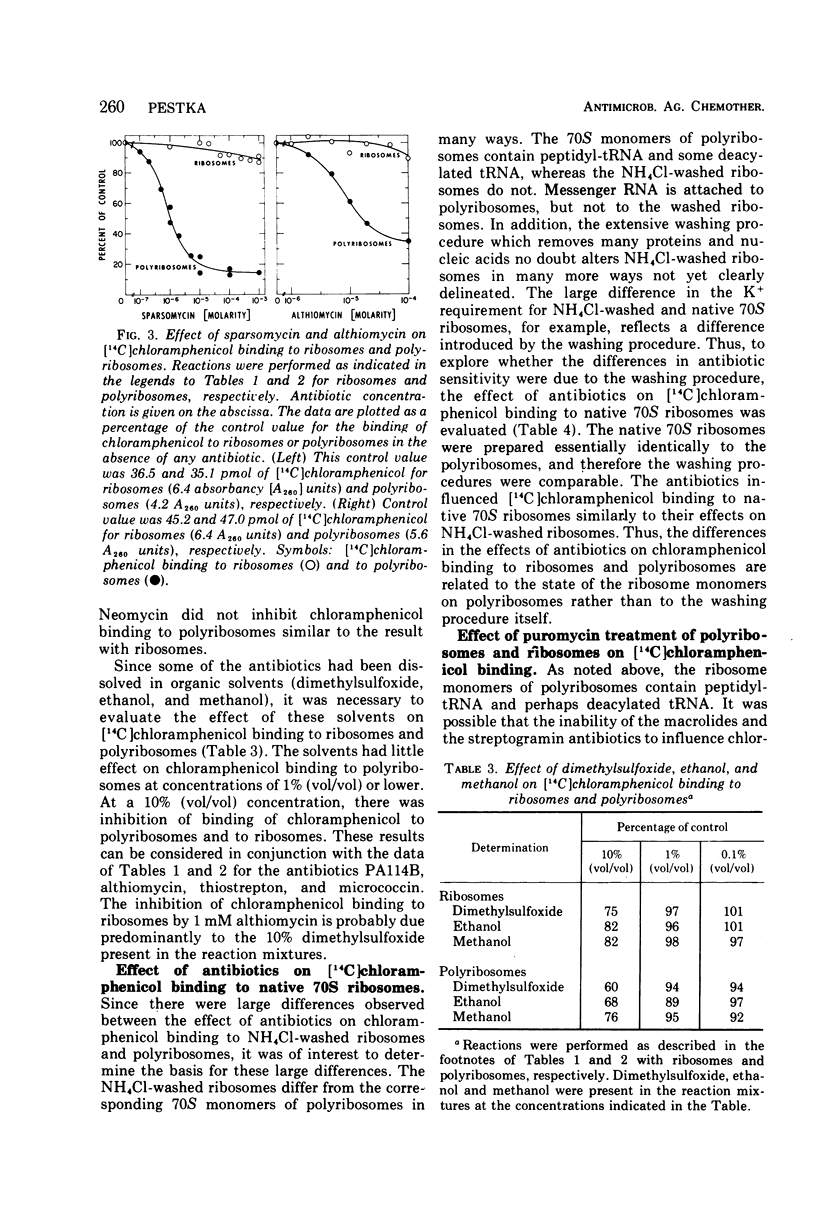
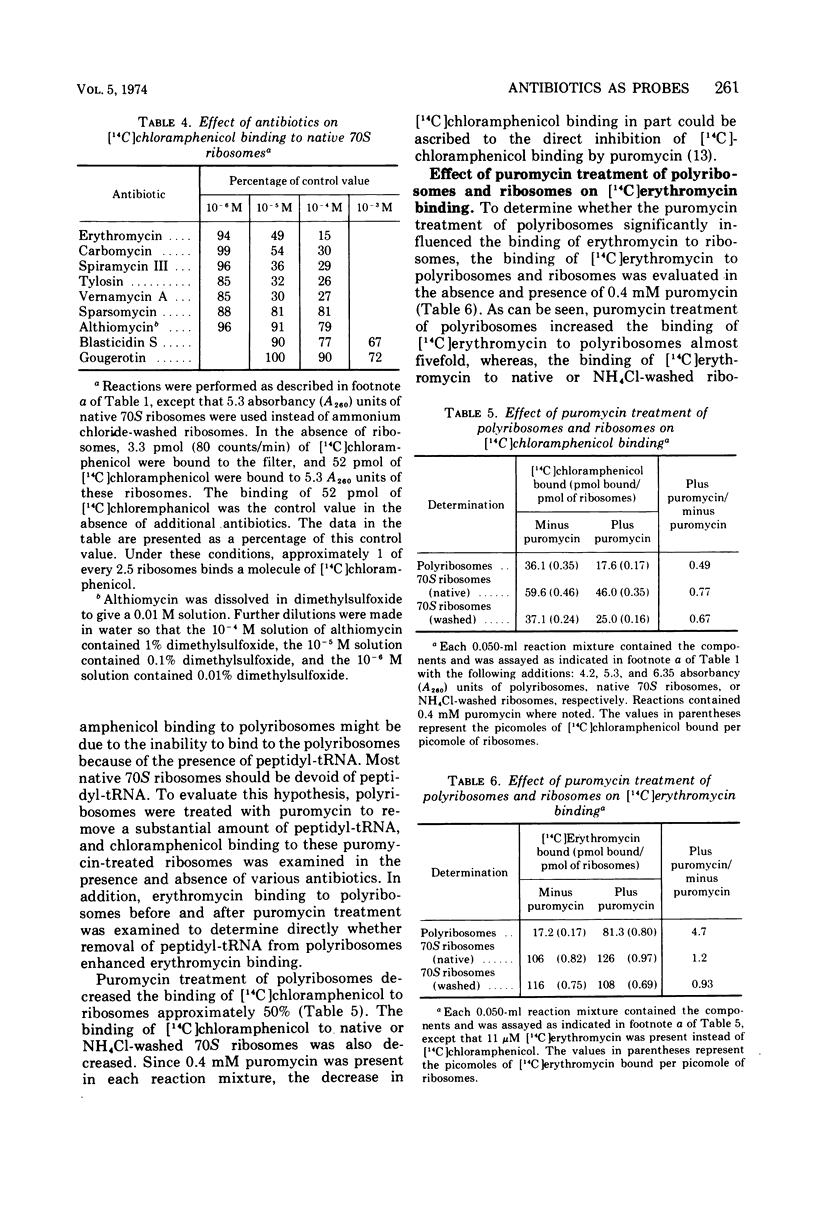
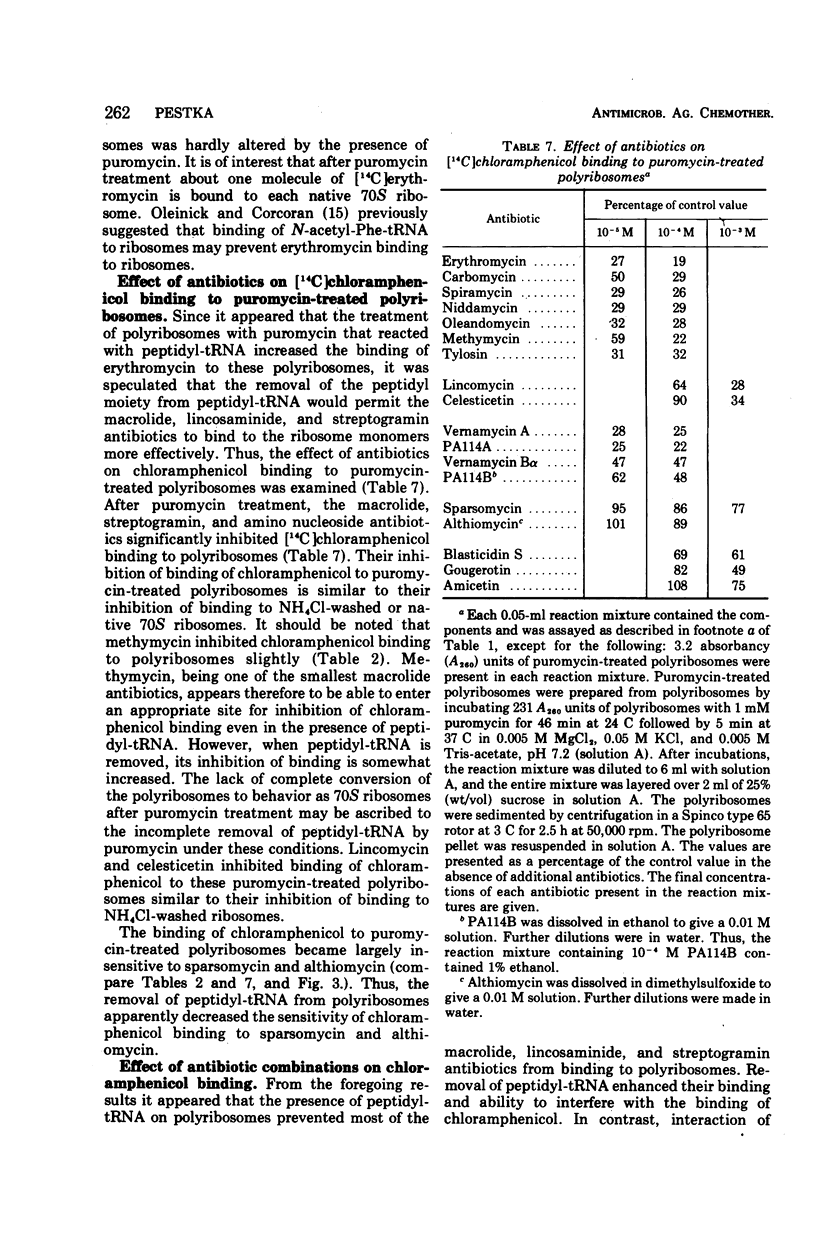
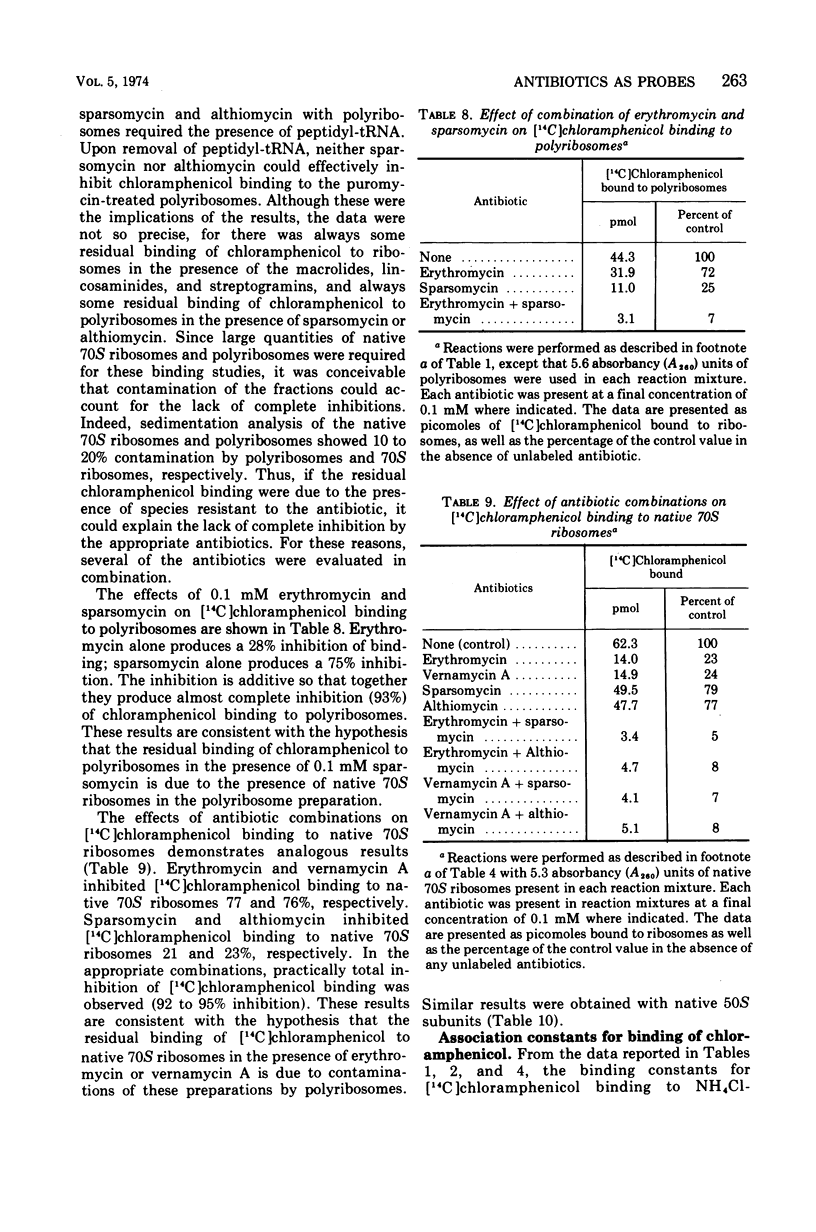
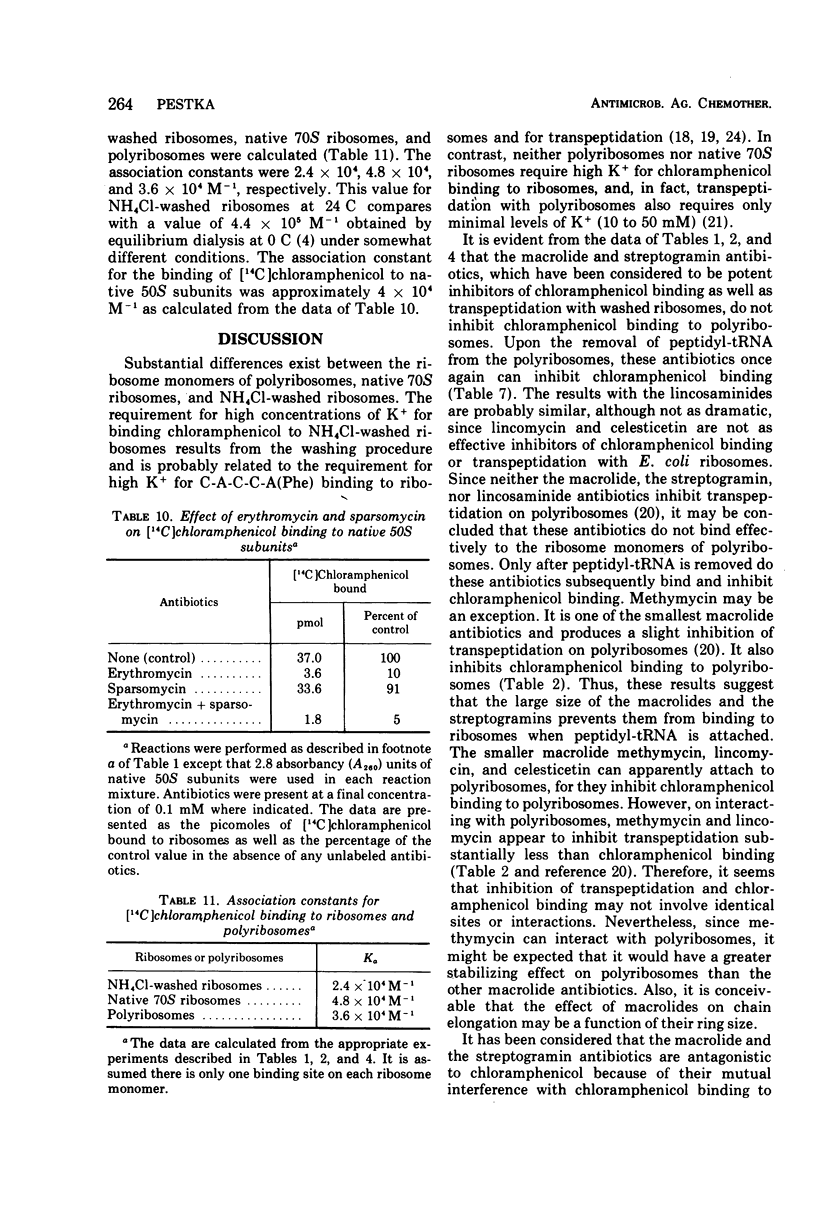
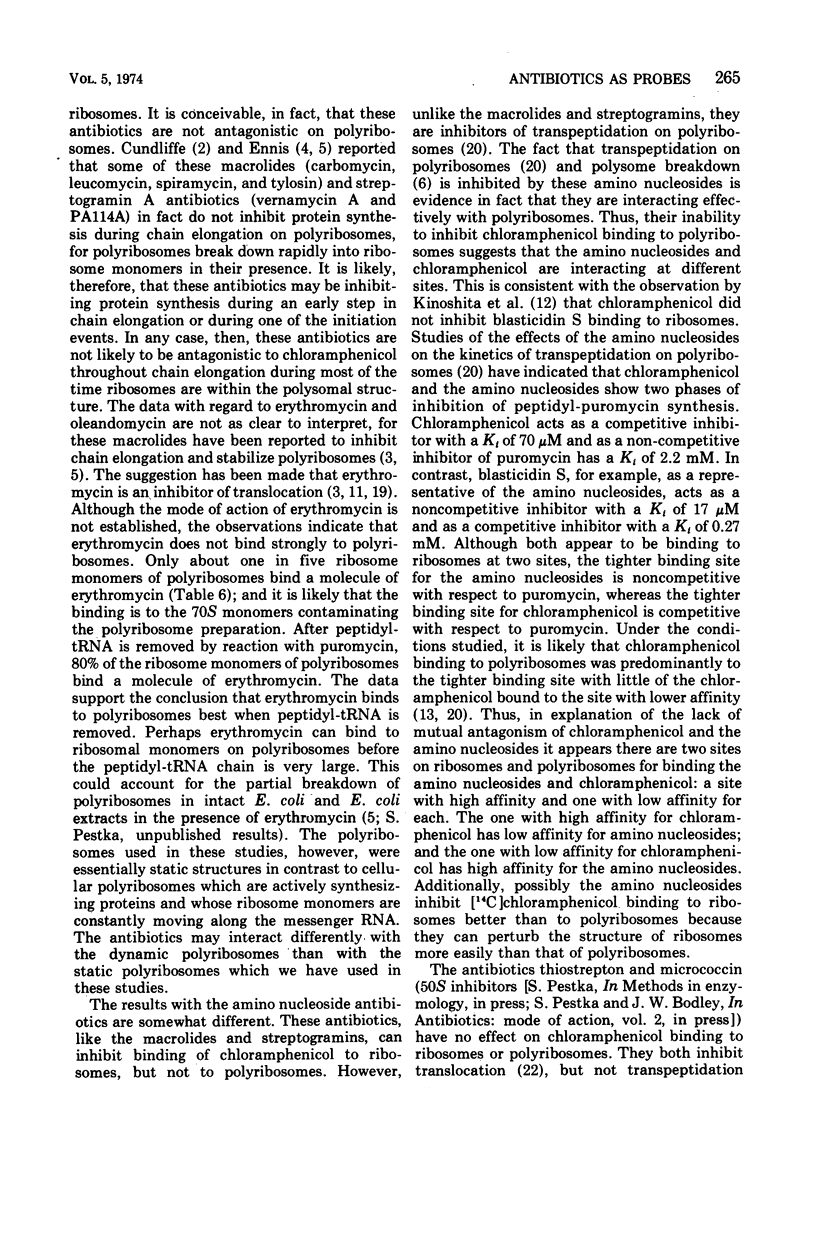


Selected References
These references are in PubMed. This may not be the complete list of references from this article.
- Chang F. N., Siddhikol C., Weisblum B. Subunit localization studies of antibiotic inhibitors of protein synthesis. Biochim Biophys Acta. 1969 Aug 20;186(2):396–398. doi: 10.1016/0005-2787(69)90020-3. [DOI] [PubMed] [Google Scholar]
- Cundliffe E. Antibiotics and polyribosomes. II. Some effects of lincomycin, spiramycin, and streptogramin A in vivo. Biochemistry. 1969 May;8(5):2063–2066. doi: 10.1021/bi00833a042. [DOI] [PubMed] [Google Scholar]
- Cundliffe E., McQuillen K. Bacterial protein synthesis: the effects of antibiotics. J Mol Biol. 1967 Nov 28;30(1):137–146. doi: 10.1016/0022-2836(67)90249-5. [DOI] [PubMed] [Google Scholar]
- Ennis H. L. Polysome metabolism in Escherichia coli: amicetin, an antibiotic that stabilizes polysomes. Antimicrob Agents Chemother. 1972 Mar;1(3):204–209. doi: 10.1128/aac.1.3.204. [DOI] [PMC free article] [PubMed] [Google Scholar]
- Ennis H. L. Polysome metabolism in Escherichia coli: effect of antibiotics on polysome stability. Antimicrob Agents Chemother. 1972 Mar;1(3):197–203. doi: 10.1128/aac.1.3.197. [DOI] [PMC free article] [PubMed] [Google Scholar]
- Fernandez-Munoz R., Monro R. E., Torres-Pinedo R., Vazquez D. Substrate- and antibiotic-binding sites at the peptidyl-transferase centre of Escherichia coli ribosomes. Studies on the chloramphenicol. lincomycin and erythromycin sites. Eur J Biochem. 1971 Nov 11;23(1):185–193. doi: 10.1111/j.1432-1033.1971.tb01607.x. [DOI] [PubMed] [Google Scholar]
- Goldberg I. H., Mitsugi K. Inhibition by sparsomycin and other antibiotics of the puromycin-induced release of polypeptide from ribosomes. Biochemistry. 1967 Feb;6(2):383–391. doi: 10.1021/bi00854a003. [DOI] [PubMed] [Google Scholar]
- Harris R., Pestka S. Studies on the formation of transfer ribonucleic acid-ribosome complexes. XXIV. Effects of antibiotics on binding of aminoacyl-oligonucleotides to ribosomes. J Biol Chem. 1973 Feb 25;248(4):1168–1174. [PubMed] [Google Scholar]
- Herner A. E., Goldberg I. H., Cohen L. B. Stabilization of N-acetylphenylalanyl transfer ribonucleic acid binding to ribosomes by sparsomycin. Biochemistry. 1969 Apr;8(4):1335–1344. doi: 10.1021/bi00832a006. [DOI] [PubMed] [Google Scholar]
- Igarashi K., Ishitsuka H., Kaji A. Comparative studies on the mechanism of action of lincomycin, streptomycin, and erythromycin. Biochem Biophys Res Commun. 1969 Oct 22;37(3):499–504. doi: 10.1016/0006-291x(69)90943-7. [DOI] [PubMed] [Google Scholar]
- Kinoshita T., Tanaka N., Umezawa H. Binding of blasticidin S to ribosomes. J Antibiot (Tokyo) 1970 Jun;23(6):288–290. doi: 10.7164/antibiotics.23.288. [DOI] [PubMed] [Google Scholar]
- Lessard J. L., Pestka S. Studies on the formation of transfer ribonucleic acid-ribosome complexes. 23. Chloramphenicol, aminoacyl-oligonucleotides, and Escherichia coli ribosomes. J Biol Chem. 1972 Nov 10;247(21):6909–6912. [PubMed] [Google Scholar]
- Mao J. C., Putterman M. The intermolecular complex of erythromycin and ribosome. J Mol Biol. 1969 Sep 14;44(2):347–361. doi: 10.1016/0022-2836(69)90180-6. [DOI] [PubMed] [Google Scholar]
- Pestka S., Brot N. Studies on the formation of transfer ribonucleic acid-ribosome complexes. IV. Effect of antibiotics on steps of bacterial protein synthesis: some new ribosomal inhibitors of translocation. J Biol Chem. 1971 Dec 25;246(24):7715–7722. [PubMed] [Google Scholar]
- Pestka S., Hintikka H. Studies on the formation of ribonucleic acid-ribosome complexes. XVI. Effect of ribosomal translocation inhibitors on polyribosomes. J Biol Chem. 1971 Dec 25;246(24):7723–7730. [PubMed] [Google Scholar]
- Pestka S., Hishizawa T., Lessard J. L. Studies on the formation of transfer ribonucleic acid-ribosome complexes. 8. Aminoacyl oligonucleotide binding to ribosomes: characteristics and requirements. J Biol Chem. 1970 Nov 25;245(22):6208–6219. [PubMed] [Google Scholar]
- Pestka S. Inhibitors of ribosome functions. Annu Rev Microbiol. 1971;25:487–562. doi: 10.1146/annurev.mi.25.100171.002415. [DOI] [PubMed] [Google Scholar]
- Pestka S. Peptidyl-puromycin synthesis on polyribosomes from Escherichia coli. Proc Natl Acad Sci U S A. 1972 Mar;69(3):624–628. doi: 10.1073/pnas.69.3.624. [DOI] [PMC free article] [PubMed] [Google Scholar]
- Pestka S. Studies on the formation of transfer ribonucleic acid-ribosome complexes. 8. Survey of the effect of antibiotics of N-acetyl-phenylalanyl-puromycin formation: possible mechanism of chloramphenicol action. Arch Biochem Biophys. 1970 Jan;136(1):80–88. doi: 10.1016/0003-9861(70)90329-2. [DOI] [PubMed] [Google Scholar]
- Pestka S. Studies on the formation of transfer ribonucleic acid-ribosome complexes. VI. Oligopeptide synthesis and translocation on ribosomes in the presence and absence of soluble transfer factors. J Biol Chem. 1969 Mar 25;244(6):1533–1539. [PubMed] [Google Scholar]
- Pestka S. Studies on the formation of transfer ribonucleic acid-ribosome complexes. XI. Antibiotic effects on phenylalanyl-oligonucleotide binding to ribosomes. Proc Natl Acad Sci U S A. 1969 Oct;64(2):709–714. doi: 10.1073/pnas.64.2.709. [DOI] [PMC free article] [PubMed] [Google Scholar]
- Pestka S. Studies on transfer ribonucleic acid-ribosome complexes. XIX. Effect of antibiotics on peptidyl puromycin synthesis on polyribosoms from Escherichia coli. J Biol Chem. 1972 Jul 25;247(14):4669–4678. [PubMed] [Google Scholar]
- Schneider J. A., Maxwell E. S. Peptidylpuromycin formation on mammalian polysomes. Studies on transpeptidation and translocation. Biochemistry. 1973 Jan 30;12(3):475–481. doi: 10.1021/bi00727a018. [DOI] [PubMed] [Google Scholar]
- Tada K., Trakatellis A. C. Mechanism of action of sparsomycin on protein synthesis. Antimicrob Agents Chemother (Bethesda) 1970;10:227–230. [PubMed] [Google Scholar]
- Vazquez D. Binding of chloramphenicol to ribosomes. The effect of a number of antibiotics. Biochim Biophys Acta. 1966 Feb 21;114(2):277–288. doi: 10.1016/0005-2787(66)90309-1. [DOI] [PubMed] [Google Scholar]
- Vazquez D. The binding of chloramphenicol by ribosomes from Bacillus megaterium. Biochem Biophys Res Commun. 1964 Apr 22;15(5):464–468. doi: 10.1016/0006-291x(64)90487-5. [DOI] [PubMed] [Google Scholar]


